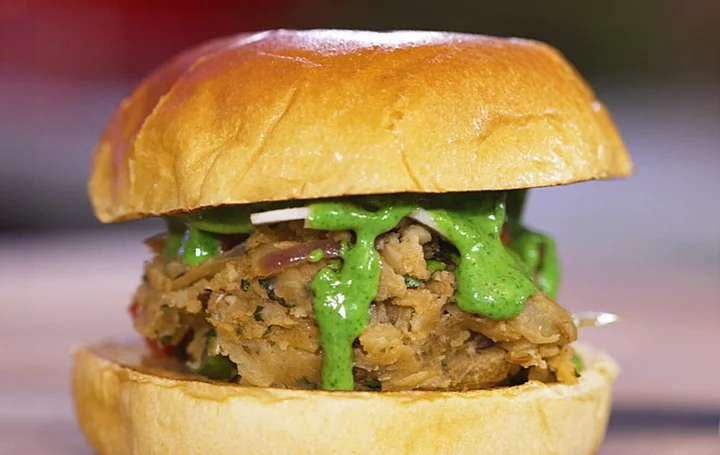
How to make the Prince of Wales’s Earthshot burger
The Prince of Wales has teamed up with popular YouTube channel, Sorted Food, to create the first Earthshot Burger. The veggie burger was created with Earthshot Prize-winning products, and a video posted on YouTube shows William handing out meals from a food van in central London with the Sorted Food chefs. The burger, filled with vegetables, spices, pickles and finished with a minty vegan mayonnaise, was developed by the sustainable packaging start-up Notpla (winner of the Build A Waste-Free World category), environmentally-friendly stove company Mukuru Clean Stoves (winner of the Clean Our Air category), and Kheyti’s Greenhouse-in-a-box, winner of the Protect and Restore Nature category. The collaboration is part of The Earthshot Prize’s new partnership with YouTube, to encourage users to create more content around climate change. Here’s how you can make your own at home… The Earthshot Burger Ingredients: (Serves 4) For the pickle: 1 cucumber, 2mm slices 1 mouli, peeled and cut into 2mm slices 200ml white wine vinegar 75g caster sugar 1tsp chilli flakes 1tbsp coriander seeds ½tbsp fennel seeds 1tsp mild chilli powder 1tbsp ground coriander seed 1tsp garam masala For the burger mix: 6tbsp vegetable oil 2tsp cumin seeds 1tsp mustard seeds, brown 1 red onion, peeled and finely chopped 6 cloves garlic, peeled and minced 40g ginger, finely chopped 2 green chillies, finely sliced 1tsp turmeric 1 red pepper, deseeded and sliced 200g white cabbage, shredded 200g cauliflower, finely chopped 100g green beans, finely sliced 500g white potato, steamed and cooled 30g coriander leaves, chopped For the sauce: 200g vegan mayonnaise 60g coriander 20g mint, leaves only 20g ginger, peeled To serve: 4 burger buns, sliced and toasted Method: For the pickle: 1. Place the sliced cucumber, mouli and one tablespoon salt in a large mixing bowl and mix well. Allow to sit for 30 minutes. 2. Add 400 millilitres water, vinegar, sugar and spices to a medium saucepan and bring to a simmer over a high heat. Once simmering, remove the pan from the stove. 3. After 30 minutes, tip the salted cucumber and mouli into a colander and rinse under cold running water then add them to the warm pickle liquid. Stir well and allow to cool. For the burger mix: 4. Heat the oil in a large saucepan over a medium heat. Add the cumin seeds and mustard seeds and fry for two minutes until fragrant and starting to pop. 5. Add the onion, garlic, ginger and chillies, along with a pinch of salt and continue to fry, stirring occasionally for five to seven minutes until the onion is starting to colour. 6. Tip in the spices and stir to combine. 7. Tip in the sliced pepper and continue to cook for five minutes until the pepper softens and releases its liquid. 8. Add in the cabbage, cauliflower and green beans, stir everything together and cover the pan with a lid. Allow the vegetables to soften for five minutes. 9. Coarsely mash the potatoes in a bowl and then add them, along with the coriander to the pan. Stir everything together and taste and adjust the seasoning. You are looking for a thick mashed potato texture. 10. Remove the pan from the stove. For the sauce: 11. Add the mayonnaise, herbs, ginger and a generous pinch of salt to the jug of a blender and puree until smooth. Taste and adjust the seasoning. To serve: 12. Divide the mashed potato and vegetable filling between the toasted buns. Top each with a couple of pinches of pickled vegetables and finish with the herb sauce. Read More ‘Nicely cooked’: Watch moment Prince of Wales serves burgers to surprised diners in London The dish that defines me: Frank Yeung’s prawn wontons Seann Walsh explains reason behind his ‘strange request’ at restaurants
2023-07-31 20:26

The dish that defines me: Frank Yeung’s prawn wontons
Defining Dishes is an IndyEats column that explores the significance of food at key moments in our lives. From recipes that have been passed down for generations, to flavours that hold a special place in our hearts, food shapes every part of our lives in ways we might not have ever imagined. There is a family scene I would love to engrave into my memory that involves my father, myself and my son, all making prawn wontons in one kitchen. Prawn wontons are so simple, like all good dishes, and they have a really special place in my heart. I have very fond memories of making them with my father, who is from Hong Kong, when I was growing up and it is my favourite dish. Now, it’s my five-year-old son’s favourite dish as well and he’s the same age I was when I first started making prawn wontons with my father, so it makes me excited to share the dish with him. When my son was younger, his Ye Ye (grandfather) would bring homemade wontons whenever he came over to my house in Peckham. But just recently, we were over at my parents’ home, and he made his first wonton. We were all very proud! It’s so nice because it’s a dish that has run right through my family, it was brought and championed here by my dad. He moved here in 1975 and has the classic first-generation immigrant story. He worked three jobs, moved around a lot, saved money and opened his first restaurant in 1985, 10 years after arriving in England. He finally retired in 2017, but he couldn’t get away from my restaurants. I opened my own establishment, Mr Bao in Peckham in 2016, and then Daddy Bao in my father’s honour. Even now when he comes around to visit, I make him talk more about restaurants. I think he enjoys it, though, and it reminds him of home. That’s really important now because ever since the 2019-2020 mass protests in Hong Kong, the country is a sad place at the moment if you’re from there. But it’s still an amazing place. My favourite part about making wontons from scratch was always the time spent with my dad. The chit chat between us, me kneeling on a stool and him standing at the counter. My hands were not as dextrous at that age and I certainly wasn’t practised, but he would be there to help show the right way to make the little parcels and finish them up for me. The bonding moment is what I cherish the most. Mum is English and she got involved too, she is actually amazing at it. Prawn wontons are also part of Christmas time for my family. Our big tradition is to have a massive steamboat on Boxing Day, which most people of Chinese descent will be familiar with. It usually involves a big, steaming pot of soup on a constant boil, and everyone sits around the table cooking fresh, raw ingredients in it and eating as they go. Prawn wontons are a big, big part of that meal for us, especially now that we have a couple of young kids running around at Christmas time, they really love it. The thing I remember most about making wontons with Dad is the filling. He has his own method for making the prawn mince that goes inside the parcels. He gets his prawns and chops them up, mixes them with any additional ingredients like garlic, and then he would make me pick up a handful of the mixture and throw it back down onto the chopping board, pick it up and throw it back down. It somehow aerates the mince and softens it, and makes it stickier so there aren’t big chunks of prawns floating around. I haven’t really adapted Dad’s recipe for myself, aside from the type of dipping sauce I like to have with them. We keep it very traditional. Oh, I suppose I do have a slight modification, actually. I like to mix gambas (white) prawns from the southwest coast of Spain with North Atlantic shrimps, which are tiny, tiny little crustaceans the size of your nail. They have got a really good flavour. I like to chop those up into the mince with the bigger prawns, add a bit of salt and white pepper, stir it through and then do the throwing method as my dad does. We usually make our own wonton skins. In a pinch, we’ll use shop-bought ones, but when we know we’ve got time we’ll make our own. At the moment, Dad makes handmade dumplings with my sister for her business so they have a dumpling skins machine – but we used to make them by hand, old-school style. He would roll them out because he could get the thickness of the skins right. It wasn’t possible when I was young as I had no idea and was clumsy! They have to be thin, but not so thin that they break or the wontons will open up in the water. It’s something I haven’t managed to master, but there’s still time. Some places don’t even use the regular wonton skins, and they are still amazing. One of my favourite restaurants ever was in Hong Kong – it has closed down now – but it was a hole-in-the-wall type of place that served two types of wontons: classic wontons or fish skin wontons. That was their entire menu. They used fish skins instead of pastry skins to wrap their wontons, and they were something like £1.20 for a bowl at the time. It was definitely the best meal I had with Mum, Dad and my sisters in Hong Kong. The wontons get boiled for two minutes. You can make a wonton soup with a base stock, using ginger, spring onions, salt, pork bones. Boil that down and skim off the top. Or, you can dip the wontons into a chili garlic sauce, which is how my dad likes – although another way I differ from Dad is that I like to add black vinegar to the sauce of soy sauce, garlic and chili, to add an extra layer of acid. You can also eat them as they are, they are completely delicious. My stomach is rumbling as I think about them. As my son gets older, it will be really nice to be able to make wontons altogether, the three generations of us at the kitchen island, chatting away. That’s what I’d like my son to take away from those sessions, the memory of doing it with his Ye Ye and me. I’d also like him to, in time, be able to link quality to food and what you’re putting in your body. I want him to understand that even though it’s so easy to go to the shop and buy something, everything starts out as a living thing. A prawn is an animal and a chive is a real plant grown in the soil. You don’t have to make it yourself and you should go to restaurants to support them, but when you do go, you’ll have a better appreciation for it. Frank Yeung is the chef-owner of Mr Bao and Daddy Bao in London. Read More The dish that defines me: Alex Outhwaite’s Vietnamese bun cha The dish that defines me: Eddie Huang’s Taiwanese beef noodle soup In Horto: Hearty, outdoorsy fare in a secret London Bridge garden Five dinner ideas from around the world to try this week Hi Barbie! Nine cocktails inspired by the doll’s most iconic outfits
2023-07-31 17:20
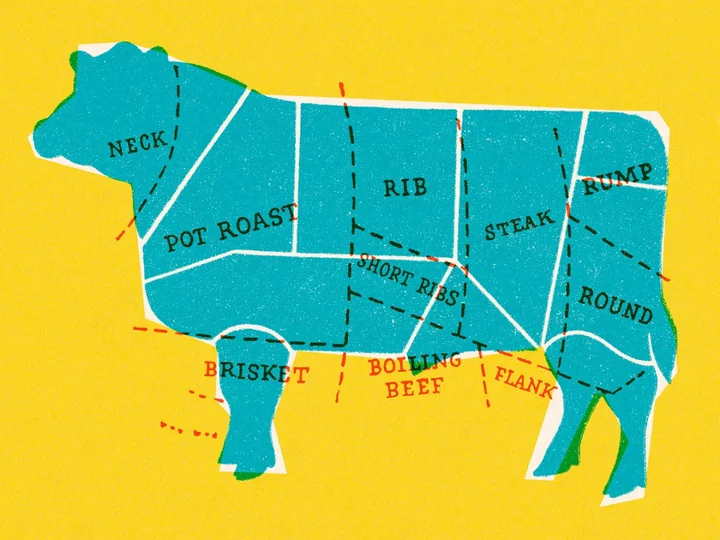
Blood, guts and cheap cuts: We need an alternative to eating animals – and ‘ethical meat’ isn’t the answer
Amber Husain was cooking dinner for a friend when she suddenly realised the meat she was preparing was a corpse. She looked at the chicken in front of her and was overcome with a visceral sense of disgust. Instead of food, she saw “a carcass – plucked, beheaded, and fleshy”. Husain was 26 when she had this epiphany, and it served as a wake-up call not just for her stomach but her mind, too – as her personal tastes shifted away from meat products, her political outlook on the meat industry and food production more broadly also altered and expanded. Five years later, that moment of revulsion forms the opening of her new book, Meat Love, in which she scrutinises the idea of “ethical” meat consumption, and dares to ask how the contemporary middle classes have come to criticise “the worst violence against animals” while still happily feeding on their flesh. Why, for example, has well-heeled, middle-class London gone nuts for slurping bone marrow from the shin bones of baby cows? Why is offal on so many trendy menus? How has contemporary culture at large come to accept that factory farms are monstrous, but that if animals are cared for, cherished and loved while alive, we should feel better about killing them for our carnivorous pleasures? “For ages, I was one of those carnivores who felt mildly bad about eating meat but just turned that into this inane, self-consciously sadistic part of the pleasure of it all,” Husein tells me. “The more my diet started to revolve around stuff that wasn’t meat, the weirder meat started to feel. Interestingly, once my stomach had been radicalised, I found I had a much greater intellectual openness to thinking about the politics of meat.” Having freed herself from the conflict of eating meat but also feeling bad about it, she found she was able to go beyond those questions of morality – which she suggests can be “stifling” – and think politically. “Now that I have no desire to eat animals, there’s nothing to stop me reckoning with what it means that the meat industry [consists of] an underclass of both humans and animals who are exploited and – in the animals’ case – killed for pleasure and profit.” This is the essential crux of Husain’s argument, and it’s something often lacking in discussions around the “ethics” of meat consumption. For Husain, the question is not, “how can humans eat meat responsibly?” but “how are certain lives devalued to an extent that their suffering can be written off, in order to ‘make a killing’?” What she’s saying, in other words, is that whether the meat on the table has come from a factory farm or an organic farm, or whether you’re tucking in at Burger King or the River Cafe, the path to the plate is still paved with violence. And, while current cultural trends may claim it is better to love and respect an animal before killing and consuming it, perhaps what this cultivates is the ability to embrace exploitation “in a spirit of virtuous indulgence”. What does it really mean, for all living beings, if love is imagined as compatible with killing? “To slide your buttery hand between the flesh and skin of a thing that, if only for a moment, you have re-learnt to perceive as a corpse, is to give an invigorating massage to your sense of political possibility,” Husain writes in Meat Love. By the slim book’s end, her invigorated “sense of political possibility” has led to “a ravenous hunger – a desire for a different culture, a different society”; a new world “in which no one, neither animal, immigrant, worker, woman, or peasant, was considered a thing to be owned, controlled, killed, or left to die”. For many, the leap from a chicken breast on a plate to the exploitation of oppressed people around the globe might seem like a vast one. Yet, it certainly seems clear that there has been a marked shift in the way meat is conceived and consumed – among the middle classes, at least. Since the turn of the millennium, foodie figures like Hugh Fearnley-Whittingstall have been promoting “seasonal, ethically produced food” as part of a broader commitment to caring for the environment. At the same time, a distinctly carnivorous spirit has taken hold – one that professes to be an “honest”, “grounded” and “down to earth” ethos. “Good food, good eating, is all about blood and organs, cruelty and decay,” Anthony Bourdain wrote at the start of the 1999 New Yorker article that would, eventually, catapult him into global foodie fame. I find it easy to laugh at Hugh Fearnley-Whittingstall and people like that, but I’m not totally convinced that they’re really the bad guys Lewis Bassett Then there’s Fergus Henderson and St John – the illustrious London restaurant, born in 1994 on the premises of a former bacon smokehouse, which popularised “nose to tail” dining. This offal-centric “no waste” approach is neatly summed up in Henderson’s oft-quoted phrase: “If you’re going to kill the animal, it seems only polite to use the whole thing.” Traditionally “cheap cuts” are “elevated” from a source of sustenance for the working classes, to a source of virtue for the urban bourgeois. According to its own cookbook, St John dishes combine “high sophistication with peasant roughness” – that winning aesthetic formula that also sees middle-class urbanites flocking to farmers’ markets and chugging natural wine. In a sharp and searing piece for food and culture newsletter Vittles, writer Sheena Patel dubs this “Rich Person Peasantcore”, asking: “Why are these influencers pretending that they themselves till the land and eat like 17th-century French peasants when in fact their chopping boards cost more than most people’s rent?” In the face of swathes of small plates adorned with offal, and slices of ham served for upwards of £20, it seems like a pertinent question not just for influencers, but also for today’s trendiest restaurateurs and diners. Lewis Bassett is a chef and the host of The Full English podcast, which, over its two seasons, has dived into everything from the birth of “modern European” cuisine to high food prices, factory farms, and why Britain is in love with Greggs. “It’s interesting the way we create these fantastical worlds for us to eat within,” he says. “It is clearly a fantasy to imagine that you can have the rural experience of a peasant in France or Italy, in modern-day Britain.” Yet, he also says that this trend is far from new. The current “rustic” style – typified by “nose to tail eating” – is, he suggests, “intimately tied with what you could call a culinary and broader cultural movement that appears in the wake of countercultural movements in the Sixties, and eventually finds its way into food, especially as some of those countercultural people get a bit older and a bit more affluence”. Essentially, “it’s the same thing that manifested in places like Habitat,” he says, of the homewares and furnishings brand founded in 1964 by Terence Conran. Both design and dining were transformed, offering experiences to the middle classes that were both refined and casual at the same time. Alongside that cultural shift, and “that fashion for pared-down forms of eating out”, Bassett notes the arrival of a broader awareness of environmental and animal welfare concerns. “It’s obviously easy to ridicule these middle-class forms of culture,” he says, “but these concerns are ones I certainly share and I think should be considerations for everyone. I find it easy to laugh at Hugh Fearnley-Whittingstall and people like that, but I’m not totally convinced that they’re really the bad guys.” So is there a danger that legitimate backlash to the “thrifty rural”, “nose to tail” trend – and bourgeois “peasantcore” more broadly – could spill over into an attack on all food industry attempts at sustainability? “I think people don’t want stuffy fine dining experiences,” Bassett says, “but at the same time, having the kind of pared-down, rustic, ‘peasant food’ – like, having ham served to you at St John costs you 20 quid – maybe people are slightly sick of that.” He quickly adds, though, that he is “not saying it can come any cheaper than 20 quid, because when you spend a lot of time and effort rearing animals properly, and paying chefs properly, and paying rents in your restaurants, that racks up”. It seems there is a tension, then, between practical and immediate ethical matters – such as paying food industry staff liveable wages or reducing food waste – and broader questions about what kind of society we wish to live in or create. Is the question of “ethical” meat consumption, as Husain suggested, “beyond morality” – a question of politics only? Or is it still, at heart, a moral dilemma, based on people’s personal sense of “right” and “wrong”? Summing up Husain’s attitude towards animals in Meat Love, Bassett suggests “she’s saying that, if you love them so much, why are you killing them? I suppose where Amber Husain and I would slightly disagree is that I’m not convinced that killing an animal is inherently wrong.” Away from the carnal appreciation and “peasantcore” of contemporary restaurant culture, meat-eating often seems to be conceived as either a “guilty pleasure” or a “grim necessity”. In all these cases, however, there appears to be an overriding sense that there is “no alternative” to a meat-eating status quo. The late cultural critic Mark Fisher famously used similar terms to define “capitalist realism”, meaning that capitalism is the only viable economic system, and thus there can be no imaginable alternative. Is it possible we’re also stuck in a kind of “carnivorous realism”? If so, it might be because the two are so interlinked. As Husain puts it, “meat is the inevitable outcome of an economic system that relies on cheap labour and cheap life. But that doesn’t mean meat is a necessity, it means a new economic order is a necessity.” Perhaps taking the leap from a vegetarian diet to full-scale social and economic revolution still seems unthinkable to many. But, in nasty, brutish and austere times, it has also perhaps never been more necessary to seriously consider who can eat, and who is made meat. “I think we need an avalanche of political will from within the food justice, land justice, climate justice and labour movements to radically transform society,” Husain says. With that as the goal, she believes it isn’t helpful “for us to be clinging to the idea of meat as a pleasure”: “If we can’t imagine something other than animal flesh to eat for dinner we might struggle to imagine an entirely different society.” ‘Meat Love: An Ideology of the Flesh’ by Amber Husain is out now Read More Between Brexit and Covid, London’s food scene has become a dog’s dinner – can it be saved? It’s time for booze bottles to have health warning labels Should I give up Diet Coke? With aspartame under suspicion, an addict speaks Food portion sizes on packaging are ‘unrealistic and confusing’, says Which? In Horto: Hearty, outdoorsy fare in a secret London Bridge garden Zero-fuss cooking: BBQ pork ribs and zingy Asian slaw
2023-07-30 13:58

Food portion sizes on packaging are ‘unrealistic and confusing’, says Which?
Portion information on food packaging is too “confusing, inconsistent or unrealistic” for people to get a clear understanding of how much sugar, fat and salt they are consuming, according to new research. Which? surveyed more than 1,200 people on portion sizes and found that a large number of people could not estimate correctly how many servings popular supermarket foods contained. The consumer champion found that respondents often assumed portions were larger than the suggested serving sizes listed on the packaging, and labelled the latter “small” and “unrealistic”. For example, more than half of respondents thought a 225g pack of halloumi would cover two to four servings, but the package information suggests it should feed seven. More than a third of respondents thought a tub of Pringles contained two to four portions, but the packaging suggests it contains six to seven servings of around 13 crisps per person. The majority (79 per cent) of those who took part in the survey thought a supermarket meal deal was designed to serve one person, given they are typically purchased for a single person’s meal. However, Which? pointed out that while the sandwich is usually for one person, the drink and snack that are usually included in the deal may be designed for two. The research also found inconsistencies in portion sizes across pack sizes for popular products. Walkers Ready Salted Crisps come in three different individual pack sizes ranging from 25g per pack in a multipack to 45g in a grab bag, but these all count as one portion. Meanwhile, a 150g sharing bag suggests that a single portion is 30g. Other products that have similar inconsistencies include Cadbury’s Dairy Milk, which have recommended serving sizes ranging from 20g to 33.5g. Which? also found inconsistencies in serving size suggestions depending on the brand, even if the amount of product in a package is similar. A 300g back of Dell Ugo tomato and mozzarella tortellini states that it serves two people, but a near-identical version by Marks & Spencer that also weighs 300g says it contains three servings. Respondents also found it difficult to estimate an appropriate portion size for drinks, it was revealed, after 229 people were asked to pour themselves a glass of wine, juice or smoothie and measure how much they served themselves. Just under half (49 per cent) of white wine drinkers poured themselves more than the recommended 125ml, with the largest pour recorded rising to more than double that (275ml). Among red wine drinkers, almost two thirds (69 per cent) poured a much larger portion, which the largest pour reaching 250ml. More than half (54 per cent) of those who drank orange juice served themselves more than the recommended 150ml, with the largest pour measuring in at 400ml. Orange juice packages show the amount of calories and sugar in a 150ml serving, which is around 62 calories and 13g of sugar. However, a 400ml glass has 166 calories and 35g of sugar, more free sugar than an adult should have in a day according to the NHS. Which? said: “Although traffic light labelling is a useful guide to the nutritional value, for it to be effective it must be based on realistic portion sizes. Manufacturers and supermarkets should look to make improvements and provide clearer labelling on serving sizes so shoppers are not misled about the food they buy.” Customers are also advised to check packaging and to measure portion sizes at home to get a clearer idea of what they should consume looks like according to the packaging suggestions. Shefalee Loth, a nutritionist at Which?, said: “Which? found people can be confused by inconsistent and unrealistic serving sizes and that the way that manufacturers provide these can sometimes make it difficult to assess just how healthy a product is. “Nutrition labelling is really valuable for consumers, including front of pack traffic light labelling, but it needs to be based on meaningful and consistent portion sizes.” Read More Men have a problem – and it won’t be solved by either Andrew Tate or Caitlin Moran Elon Musk reacts to ex-wife Talulah Riley’s engagement to Thomas Brodie-Sangster Thomas Brodie-Sangster references Love Actually in sweet engagement announcement with Talulah Riley In Horto: Hearty, outdoorsy fare in a secret London Bridge garden Zero-fuss cooking: BBQ pork ribs and zingy Asian slaw Brad Pitt and Angelina Jolie ‘set to try and resolve’ longrunning vineyard dispute
2023-07-28 22:46
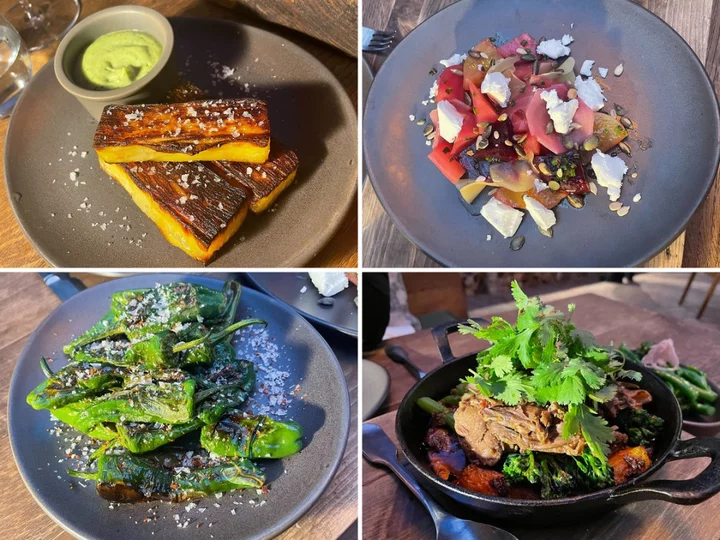
In Horto: Hearty, outdoorsy fare in a secret London Bridge garden
Walking into In Horto feels like walking into someone’s garden after the green thumbed designers of Your Garden Made Perfect have had their way with it. Stylish yet homely, with thought put into making every corner feel like you’re stepping into someone’s al fresco dinner party – hexagonal red brick flooring, rattan lamp shades and roof, wooden dining tables and chairs, as well as rustic dishes and serving plates. Potted plants welcome you at the entrance and vines twirl around the edges of the restaurant, which gives it an even more cloistered feeling. Just a five minute walk from London Bridge, right next to Flat Iron Square, In Horto has a distinctly different vibe to its packed surroundings. There’s the Borough Market crowd, where inching behind tourists is only made worth it if you procure a sausage roll from the Ginger Pig (mmm, dreamy); while Flat Iron Square boasts a hipper, boozier clientele. In Horto offers a bit of an oasis from both – a quieter, calmer place to sit down and have a meal. In Horto is a venture by TVG Hospitality, also known as The Venue Group, which boasts Mumford and Sons member Ben Lovett as one of its backers. The group also operates Flat Iron Square, which it moved from its original location on the corner of Southwark Bridge Road and Union Street to its current home last year. So it makes sense that the company is trying to develop the area by providing more restaurants with different concepts – it also opened Carrubo next to In Horto, a Mediterranean-inspired “light bites” place. The clue to why the restaurant feels so much like a garden party is in the name; In Horto in Latin is “in the garden”. The cooking on display here is very much focused on outdoorsy, wood-fired cooking, with a beautiful large domed oven taking pride of place behind the counter. Almost every dish is baked, roasted or grilled in this hard-working piece of equipment, bar things like the charcuterie board or the burrata and caponata, but even that has a touch of fire with the addition of smoked white balsamic dressing. In Horto’s menu moves with the seasons, but some things that are a staple and absolutely worth having again and again. The confit potato chips, which have been described as an “uncanny” dupe of Quality Chop House’s own version, are very, very good – layers of nearly paper thin potatoes layered and cooked in a thick wedge, before being portioned into chunky batons and roasted so that they caramelise and crisp up on the outside, but retain a delicious softness on the inside. The heritage beetroot with vegan feta and sunflower and pumpkin seeds also went down a treat, with the earthy, gorgeously red and purple root vegetables allowed to shine. We were big fans of the ’nduja butter and burnt onion butter that can be ordered and slathered with relish on bread. Also enjoyed were tenderly shredded venison batons ensconced in crispy crumbs, and while I generally find padron peppers to be a bit… well, boring, In Horto’s were covered in a healthy sprinkling of Aleppo salt that gave the soft, slightly charred vegetables that much-needed crunch. The mains were hearty and great for sharing, although perhaps less exciting than the starters and sides. There’s only so many roasted vegetables you can eat before it starts to taste a little monotonous. Having said that, the slow roasted braised lamb was a triumph; tender and juicy, with a delicious amount of fat that melts on the tongue. The real joy of In Horto’s menu is that it is all made to be shared, which I love. There is something so comforting and communal about passing dishes to one another, making sure everyone tries a little bit of everything. After all that food, it’d make sense that there was little room for dessert. Except I’m nothing if not determined. We had to be sensible though – the tarte tatin with vanilla ice cream sounded bloody lovely, but would have been far too much and we would have had to be rolled home. Being the balanced and rational eaters we are, we opted to share the rich, luxurious chocolate mousse with honeycomb and salted caramel ice cream. Unwise? Perhaps, just a little. But I have no regrets. In Horto, 53b Southwark St, London, SE1 1RU | inhorto.co.uk | 020 3179 2909 Read More The Union Rye, review: Finally, a decent restaurant in this charming East Sussex town Forest Side: Heavenly Cumbrian produce elevated to Michelin-starred proportions I tried the food at Idris Elba’s restaurant – he should stick to wine
2023-07-28 21:15
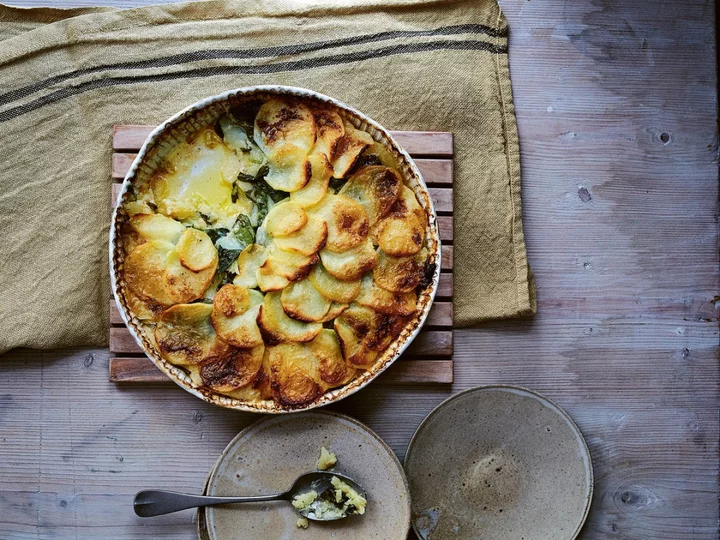
How to make Dauphinoise potatoes
Layers of potato interleaved with clotted cream, spinach, a hint of garlic and nutmeg – a dish that will bring you together with people you love,” says chef Emily Scott. “Wild garlic is a perfect replacement for the spinach, when it is in season. It has a subtle fragrance and works in pesto, risottos, pasta, scones and here in this delicious dauphinoise.” Dauphinoise potatoes with spinach and clotted cream Serves: 8 Ingredients: 50g (2oz) unsalted butter 300g (10½ oz/1½ cups) clotted cream 150ml (5fl oz/scant 2⁄3 cup) creme fraiche or Rodda’s double (heavy) cream 1 whole nutmeg, for grating 1.2kg (2lb 10oz) waxy potatoes, peeled (Desirée potatoes work well) 900ml (30fl oz/3½ cups) full-fat milk 2 bay leaves 1 garlic clove, halved lengthways 200g (7oz) baby spinach, washed and stalks removed (wild garlic is a perfect alternative when in season) Cornish sea salt and freshly ground black pepper Method: 1. Preheat the oven to 160C (140C fan/320F/gas 2). Grease the sides and bottom of an oven-to-table dish with a little of the butter and set the rest aside to use later. 2. Place the clotted cream and creme fraîche in a bowl and stir together, then add a pinch of sea salt, some black pepper and a grating of nutmeg. 3. Cut the potatoes into 2.5mm (1⁄8 in) slices. Place them in a heavy-based pan and cover with the milk, then add a good pinch of sea salt, another grating of nutmeg, the bay leaves and garlic. Bring to the boil and cook for 10 minutes (be careful – the bottom of the pan can catch). Drain, discarding the milk, garlic and bay leaves. 4. Carefully layer the potatoes in the buttered dish alternating them with layers of spinach, seasoning each layer with salt and pepper. Make sure the top and bottom layers are just potato. Pour over the clotted cream mixture, making sure the top layer is just covered. Finish the top off with some more grated nutmeg and a few knobs of the remaining butter. 5. Bake in the middle of the oven for 1 hour, or until golden brown and a table knife passes through with ease. Allow to rest. ‘Time & Tide’ by Emily Scott (Hardie Grant, £28).
2023-07-26 13:58
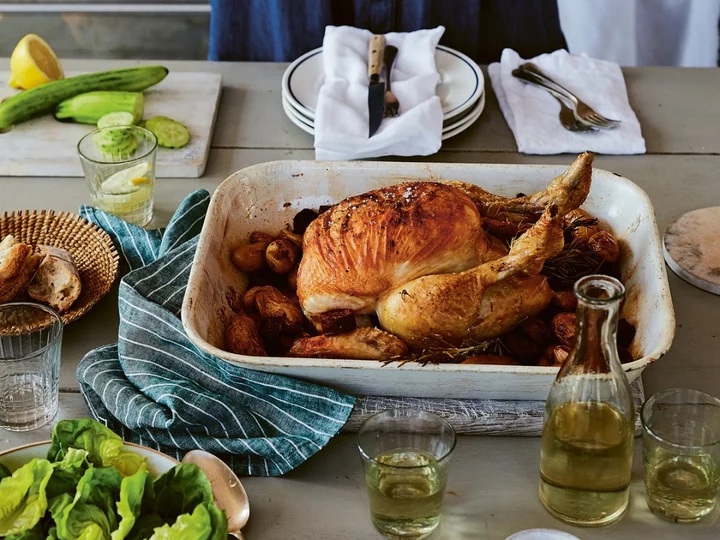
One-pot roast chicken with chorizo, garlic and rosemary
There is nothing more comforting than a roast chicken – a go-to every week and something my family are always happy to see,” says chef Emily Scott. “The chorizo, lemon and rosemary create a wonderful gravy of buttery golden juices; with the potatoes and garlic, it really is a delicious one-pot recipe.” Roast chicken with chorizo, garlic and rosemary Serves: 4 Ingredients: 1 whole properly free-range chicken (about 1.5kg/3lb 5 oz) 50-100g (2-3½oz) unsalted butter, softened 6 rashers of unsmoked streaky bacon 2 lemons, halved 8 rosemary sprigs 12 garlic cloves, left whole and unpeeled 2 tbsp olive oil 300g (10 ½oz) chorizo, thickly sliced 500g (1lb 2oz) small new potatoes, left whole Cornish sea salt and freshly ground black pepper Method: 1. Preheat the oven to 200C (180C fan/400F/gas 6). Place the chicken in an oven-to-table roasting dish. Rub the breasts and legs with the butter, season with sea salt and freshly ground black pepper, then place the streaky bacon over the breasts of the chicken (this protects the breast meat for the first part of the cooking, keeping the meat moist and adding delicious flavour. The crispy bacon becomes the cook’s perk). 2. Place the lemon halves and most of the rosemary in the cavity. Arrange the garlic cloves around the chicken in the oven dish, then drizzle the whole chicken with the olive oil. Roast in the oven for 15-20 minutes until the bacon is crispy. 3. Remove the dish from the oven, remove the bacon and set aside. Baste the chicken with the buttery and lemony juices, then arrange the slices of chorizo and small potatoes around the chicken with the remaining rosemary sprigs. Return to the oven to roast for 45 minutes–1 hour until the chicken is golden brown and the juices run clear (test by inserting a skewer into a leg). 4. Remove from the oven and allow to rest for 10 minutes. Carve and serve with the buttery, golden juices, with the roasted potatoes and chorizo, accompanied by greens or a green salad. ‘Time & Tide’ by Emily Scott (Hardie Grant, £28).
2023-07-26 13:58
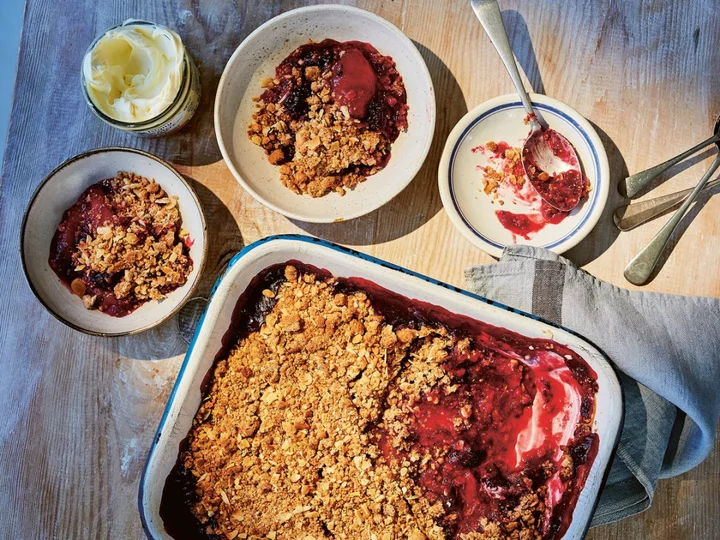
Simple, versatile, delicious: Blackberry and peach crumble
This recipe is so simple and versatile – I use it to top fruit throughout the seasons,” says chef Emily Scott. “It is lighter than a traditional oat crumble topping, and delicious served with custard or crème fraîche.” Blackberry and peach crisp Serves: 4 Ingredients: For the Amaretti crumble topping: 160g (5½oz) amaretti biscuits 80g (3oz/scant 1 cup) flaked (slivered) almonds 75g (2½oz) unsalted butter, at room temperature 50g (2oz/scant ½ cup) plain (all-purpose) flour 50g (2oz/scant ¼ cup) caster (superfine) sugar For the bramble and peach filling: 350g (12oz) blackberries 6 peaches, skinned and stoned (pitted), sliced (if using frozen peaches, thaw and drain first) 100g (3½oz/scant ½ cup) caster (superfine) sugar 3 tbsp cornflour (corn starch) slaked with 2 tbsp water Zest and juice of ½ lemon Method: 1. Preheat the oven to 200C (180C fan/400F/gas 6). For the crumble topping, blitz the amaretti biscuits with the flaked almonds in a food processor to a rubble. 2. In a mixing bowl, rub the butter and flour together to resemble breadcrumbs, then add the sugar along with the almond rubble and mix together. 3. Spread the mixture out over a baking sheet and bake in the oven for 10-15 minutes until golden. Allow to cool. 4. For the filling, place the blackberries, peaches, sugar, cornflour mixture, lemon zest and juice in a heavy-based saucepan and slowly bring to a simmer, stirring all the time to allow the sugar to dissolve. Cook until the fruit is tender. 5. Transfer to an oven-to-table baking dish and sprinkle over the amaretti crumble topping. Finish off in the oven for 5–6 minutes. Don’t forget the cream. ‘Time & Tide’ by Emily Scott (Hardie Grant, £28).
2023-07-26 13:52

Emily Scott: ‘It’s quite normal for people with eating disorders to end up working in food’
Emily Scott has called the UK’s southernmost county home for 25 years, but the chef’s roots in the region go back even further. “I spent a lot of time in Cornwall as a child, because my grandparents had a house down here,” says Scott, 48, on a video call from her home near Newquay. “And also in France, because my grandfather was half-French and they lived out in Provence.” Born in Sussex, she moved to the picturesque village of Port Isaac aged 23 and married her first husband, a fisherman, and the couple had three children, Oscar, 21, Finn, 20, and Evie, 18. “Sadly, I divorced the fisherman – or not sadly, I’m not sure – but actually, it’s all very amicable. “But I chose to stay in Cornwall… and my career has just grown and got better and better.” Scott’s first foray into food was the seaside Harbour Restaurant in Port Isaac, followed by eight years running the much-loved St Tudy Inn gastropub and rooms. Now, she’s creative director (“I’m not apron-on as much as I used to be”) at Emily Scott Food, the restaurant that sits on the sea wall at Watergate Bay. What unites all these culinary outposts? “I’ve been banging the simplicity drum for a long time – my food’s all about seasonality, but also not too much faffing around.” That ethos is evident in her second cookbook, Time & Tide, which includes plenty of one-pot main dishes, simple suppers and satisfying bakes. “It’s about times of day,” says Scott, who lives with her partner Mark Hellyar, a winemaker, and her children. “There’s a lovely chapter called ‘morning cafe’ with lots of nods to my French roots, because that’s just a very natural thing for me. We’ve got ‘rise and shine’, meaning breakfast time, we’ve got ‘seaside soirees’.” The recipes reflect Scott’s trademark Cornish-French fusion with seafood – scallops, mussels, mackerel, crab – taking centre stage alongside French culinary classics like beurre blanc, bouillabaisse, ratatouille and creme brulee, while Cornish sea salt and clotted cream appear on many an ingredients list. The book cover features a quote from American actor and foodie Stanley Tucci, who has become a friend. “It’s just been a very natural coming together through food,” says Scott. “You know, when you see him on television in his Italy series, he genuinely is that person. He genuinely loves food and wine, and that’s what connects everyone in my view.” The chef and author didn’t always have such a favourable view of feasting. She had anorexia in her teens and was forced to drop out of school. After going in and out of treatment, she was offered the opportunity to go and work in a hotel restaurant in France. “It’s quite a normal thing for people with eating disorders to end up in food, I think, because, I mean, you can’t give up food,” Scott says. “I just ended up – kind of through choice – just recovering, and turning my rather unhealthy relationship with food around, and finding the joy of cooking for people.” In 2021, the restauranteur got the chance to cook for some very important people when she was asked by the Cabinet Office to cater a dinner for world leaders at the G7 summit in Cornwall’s Carbis Bay. “They were looking for something slightly different – they didn’t want the very formal, old school, white gloves [style],” Scott says. “I submitted my menu and told them I’d be giving them tea towels as napkins, and we’d have French Duralex glasses, mismatched cutlery, that kind of thing, and they loved it.” On the menu was melon gazpacho, turbot with miso beurre blanc sauce, and strawberry and elderflower pavlova, followed by “little mini ice creams for the petit fours and Cornish fudge we made. So it was all quite nostalgic nods to the seaside”. What was it like emerging from the kitchen at the end of the meal to greet diners including then UK prime minister Boris Johnson, US president Joe Biden, French president Emmanuel Macron and German chancellor Angela Merkel? “It was literally like, you know when you go to a friend’s house for dinner, but you’re really late and you turn up and everyone’s had a drink? I was suddenly surrounded,” Scott recalls. “President Biden had his arm around me, I had Macron and his wife signing my book, because my book had come out the day before, then I had Angela Merkel saying, ‘We must get a photograph now, come on’. It was quite a moment really.” Even better, the proud mum got to share the experience with her kids: “Oscar, my eldest, and my partner’s daughter served the world leaders, and my son Finn was in the kitchen cooking as part of my team. I thought, as a parent, I’m done!” Plus, the feedback on the food from the VIPs was top notch. “They loved it. And what was so nice is I said to [the organisers], ‘I want them to be relaxed. I want them to stay longer’,” Scott says. “The secret service were like, ‘They ran over time, they were so relaxed’. We did our job.” ‘Time & Tide’ by Emily Scott is (Hardie Grant, £28).
2023-07-26 13:51
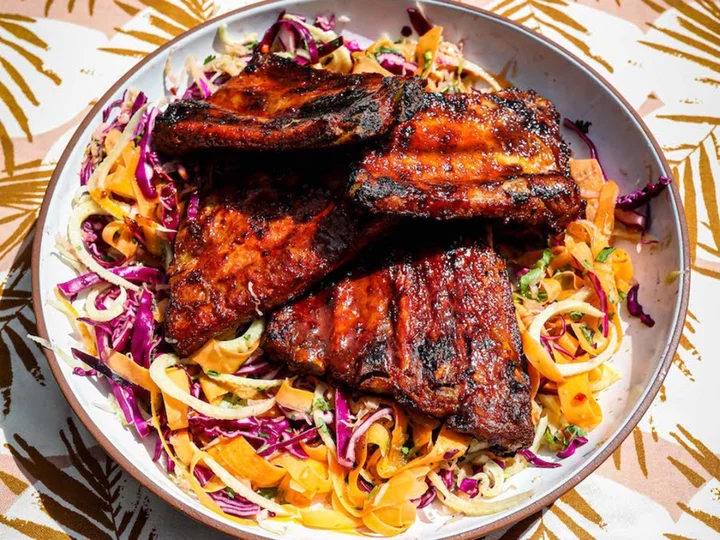
Zero-fuss cooking: BBQ pork ribs and zingy Asian slaw
Sweet and smokey, melt off the bone BBQ pork ribs and a zingy, Asian-style slaw are this week’s match made in heaven. Ideal for family get togethers and al fresco dining, this showstopper summer dish requires zero-fuss cooking. Serve with cold beers and pitta breads to mop up the goodness. BBQ pork ribs and slaw Serves: 4 Ingredients: 800g BBQ pork ribs 1 tbsp hoisin sauce (optional) For the slaw: 2 carrots, peeled into ribbons ¼ red cabbage, shredded ½ fennel bulb, finely sliced ½ red chilli, deseeded and finely diced 1 tbsp root ginger, grated 2 tbsp sauerkraut 2 tbsp hot lemon sauce 2 tbsp chopped coriander Method: To cook the pork ribs, wrap them in tin foil and bake them in the oven at 150C for 1-1.5 hours, or if you have a BBQ, use that! Remove them from the tin foil and increase the temperature of your grill to 200C. Grill for 15-20 mins, basting regularly with the remaining BBQ marinade (and hoisin sauce, if you’re using it). To prepare the slaw, peel your carrots into ribbons and toss them in a large bowl with the shredded red cabbage, finely sliced fennel, and sauerkraut. Add in the grated root ginger, chopped red chilli and coriander. Instead of mayonnaise, try adding hot lemon sauce to your slaw for a zingy, spiced version. Mix well and season to taste, then serve alongside your BBQ ribs. Read More Five dinner ideas from around the world to try this week Hi Barbie! Nine cocktails inspired by the doll’s most iconic outfits The National Portrait Gallery’s new restaurant is fabulous upgrade Three barbecue recipes to try that aren’t burgers The dish that defines me: Alex Outhwaite’s Vietnamese bun cha 3 TikTok-approved recipes for picnic season
2023-07-25 13:48
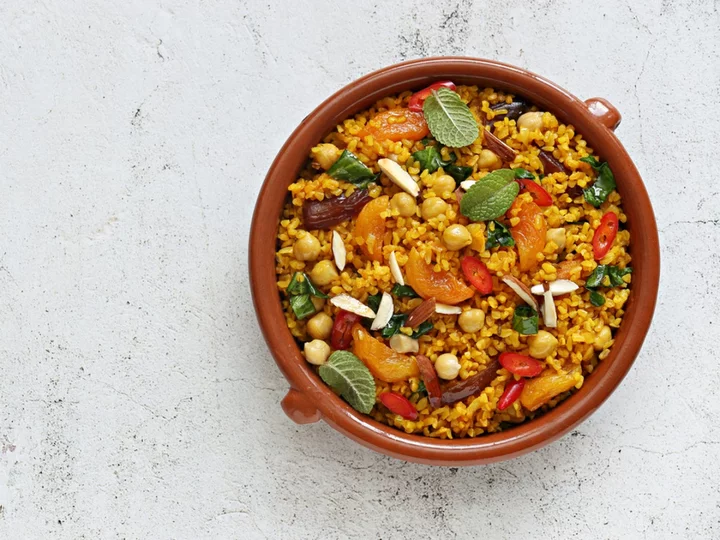
Five dinner ideas from around the world to try this week
Sometimes dinnertime is not just about satisfying our hunger. It’s a chance to embark on a culinary adventure from the comfort of our homes. To elevate your dining experience this week, we’ve curated a selection of five diverse and sustainable dinner recipes that celebrate global powerhouses of flavour while keeping an eye on our ecological footprint. Transport yourself to the bustling markets of Morocco with an aromatic vegetarian taigne. Embracing the harvest of the season, this hearty dish brings together the earthiness of butternut squash and carrots with the protein-packed goodness of chickpeas. Topped with a zesty lemon-dill sauce, the baked salmon dish below offers a refreshing twist to your taste buds while delivering a dose of healthy omega-3 fatty acids. A true taste of British comfort, a classic beef and mushroom pie is a hearty masterpiece that showcases locally sourced beef. The recipe also minimises waste and maximises taste, making it an economical choice for families. Capturing the vibrant colours of the Mediterranean, stuffed peppers are a celebration of wholesome and vegetarian goodness. Filled with couscous, chickpeas and a medley of vegetables, this dish burts with nutritious delights. Lastly, journey to the aromatic landscapes of Thailand with a tantalising green curry. Tender chicken thighs dance harmoniously with fresh vegetables, bathed in a luscious coconut curry sauce. Bon appétit! Spiced vegetable tagine This Moroccan-inspired vegetarian tagine is bursting with flavour from seasonal vegetables and aromatic spices. It’s perfect for a cosy dinner and packed with nutritious goodness. Serves: 4 Prep time: 15 minutes | Cooking time: 1 hour Ingredients: 2 tbsp olive oil 1 large onion, finely chopped 3 garlic cloves, minced 2 tsp ground cumin 1 tsp ground coriander 1 tsp ground cinnamon ½ tsp ground ginger 1 butternut squash, peeled and diced 2 carrots, peeled and sliced 1 tin (400g) chickpeas, drained and rinsed 1 tin (400g) chopped tomatoes 500ml vegetable broth 100g dried apricots, chopped Salt and pepper to taste Fresh coriander leaves for garnish Method: 1. Heat the olive oil in a large pot over medium heat. Add the chopped onion and garlic, sauté until softened. 2. Stir in the ground cumin, coriander, cinnamon, and ginger. Cook for another minute until fragrant. 3. Add the butternut squash and carrots, tossing them with the spices. 4. Pour in the chickpeas, diced tomatoes, vegetable broth, and chopped apricots. Season with salt and pepper. 5. Bring the mixture to a boil, then reduce the heat to low, cover the pot, and let it simmer for about 1 hour or until the vegetables are tender. 6. Serve the tagine over couscous or rice, and garnish with fresh coriander leaves. Baked salmon with lemon-dill sauce This delicious and sustainable salmon dish is baked to perfection and served with a zesty lemon-dill sauce. It’s a delightful dinner that’s easy to prepare and full of omega-3 fatty acids. Serves: 2 Prep time: 5 minutes | Cooking time: 20 minutes Ingredients: 2 salmon fillets 1 tbsp olive oil 1 lemon, thinly sliced Salt and pepper to taste ¼ cup (60g) plain yogurt 1 tbsp fresh dill, chopped 1 tsp lemon zest 1 tsp lemon juice Method: 1. Preheat the oven to 200C (180C fan). Grease a baking dish with olive oil. 2. Place the salmon fillets in the baking dish. Season with salt and pepper, then lay lemon slices on top of each fillet. 3. Bake the salmon for 15-20 minutes or until it flakes easily with a fork. 4. While the salmon is baking, prepare the lemon-dill sauce. In a small bowl, mix together the plain yogurt, fresh dill, lemon zest, and lemon juice. 5. Serve the baked salmon with the lemon-dill sauce drizzled on top. Beef and mushroom pie This classic British beef and mushroom pie is a comforting and hearty dish, perfect for a family dinner. The tender beef and earthy mushrooms are enveloped in a rich gravy, all wrapped in a flaky pastry. Serves: 6 Prep time: 20 minutes | Cooking time: 2 hours Ingredients: 500g beef stew meat, diced 2 tbsp vegetable oil 1 large onion, finely chopped 2 garlic cloves, minced 250g button mushrooms, sliced 2 tbsp plain flour 500ml beef broth 2 tsp Worcestershire sauce Salt and pepper to taste 1 pack (320g) ready-rolled puff pastry 1 egg, beaten Method: 1. Preheat the oven to 180C (160C fan). 2. In a large oven-safe pot, heat the vegetable oil over medium-high heat. Add the diced beef and brown on all sides. Remove the beef from the pot and set it aside. 3. In the same pot, sauté the chopped onion and garlic until softened. Add the sliced mushrooms and cook until they release their juices. 4. Stir in the plain flour and cook for a minute to form a roux. 5. Pour in the beef broth and Worcestershire sauce, stirring to combine. Season with salt and pepper. 6. Return the browned beef to the pot, cover with a lid, and transfer the pot to the preheated oven. 7. Bake the beef mixture for about 1 hour and 30 minutes or until the beef is tender and the gravy has thickened. 8. Meanwhile, roll out the puff pastry and cut it to fit the top of the pie dish. 9. Once the beef mixture is done, pour it into a pie dish and cover it with the puff pastry. Brush the pastry with beaten egg for a golden finish. 10. Bake the pie in the oven at 200C (180C fan) for 20-25 minutes or until the pastry is puffed and golden. Mediterranean stuffed peppers These vibrant Mediterranean stuffed peppers are a flavourful vegetarian option that’s easy to make. Filled with couscous, chickpeas, and Mediterranean vegetables, they are a healthy and delicious dinner choice. Serves: 4 Prep time: 15 minutes | Cooking Time: 25 minutes Ingredients: 4 large bell peppers (any color) 100g couscous 200ml vegetable broth 1 tin (400g) chickpeas, drained and rinsed 1 courgette, diced 1 red onion, diced 1 tbsp olive oil 1 tsp dried oregano ½ tsp ground paprika Salt and pepper to taste Fresh parsley for garnish Method: 1. Preheat the oven to 200C (180C fan). 2. Cut the tops off the bell peppers, removing the seeds and membranes. Brush the outside of the peppers with olive oil. 3. In a saucepan, bring the vegetable broth to a boil. Remove from heat, add couscous, cover, and let it sit for 5 minutes until fluffy. 4. In a separate pan, heat olive oil over medium heat. Add the diced zucchini and red onion, sautéing until softened. 5. Stir in the cooked couscous, chickpeas, dried oregano, ground paprika, salt, and pepper into the sautéed vegetables. 6. Stuff the mixture into the prepared bell peppers and place them in a baking dish. 7. Bake the stuffed peppers for 20-25 minutes or until the peppers are tender and slightly charred on the outside. 8. Garnish with fresh parsley before serving. Thai green curry with chicken Transport your taste buds to Thailand with this aromatic and creamy Thai green curry. Made with tender chicken and seasonal vegetables, it’s a delightful balance of spicy, savoury, and coconut goodness. Serves: 4 Prep time: 15 minutes | Cooking time: 25 minutes Ingredients: 500g boneless chicken thighs, sliced 2 tbsp vegetable oil 2 tbsp green curry paste 400ml coconut milk 1 red bell pepper, thinly sliced 100g green beans, trimmed and halved 1 courgette, sliced 2 tbsp fish sauce 1 tbsp brown sugar Fresh basil leaves for garnish Cooked jasmine rice to serve Method: 1. In a large pan or wok, heat the vegetable oil over medium heat. Add the green curry paste and cook for a minute until fragrant. 2. Stir in the sliced chicken and cook until it’s browned on all sides. 3. Pour in the coconut milk and bring the mixture to a simmer. 4. Add the sliced red bell pepper, green beans, and courgette to the curry. Cook until the vegetables are tender-crisp. 5. Season the curry with fish sauce and brown sugar, adjusting the seasoning to taste. 6. Serve the Thai green curry over jasmine rice and garnish with fresh basil leaves. Read More Hi Barbie! Nine cocktails inspired by the doll’s most iconic outfits The National Portrait Gallery’s new restaurant is fabulous upgrade Three barbecue recipes to try that aren’t burgers The dish that defines me: Alex Outhwaite’s Vietnamese bun cha 3 TikTok-approved recipes for picnic season Imad Alarnab: In Calais’ Jungle refugee camp, food restored our faith
2023-07-24 17:15
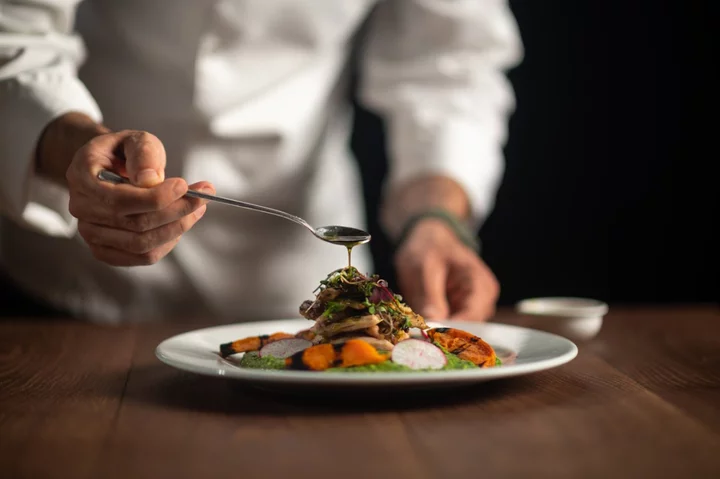
Restaurant introduces ‘minimum spend’ that will see solo diners pay double to eat alone
A restaurant in London has sparked criticism over its decision to introduce a minimum spend next month that will see solo diners charged double for their meals. In August, Alex Dilling at Hotel Café Royal, which boasts two Michelin stars, will increase the prices of its tasting menus. Currently, a five-course tasting menu costs £125 per person, while it’s £175 for seven courses. However, from 17 August, the restaurant will increase its prices by 11 per cent, bringing five courses to £165 and seven courses to £195. This is due to an increase in supplier costs and rising staff shortages in London, due to Brexit, that has put pressure on the business. For those dining alone, though, the new minimum spend means solo visitors could be charged a minimum of £330 to visit the restaurant due to the volume of requests they receive. However, the restaurant confirmed that they keep one to two tables for solo diners for every service without the minimum spend. So solo diners who book within 24 to 48 hours of their required booking time could be able to swerve the minimum spend depending on whether those tables are available at the time. Nonetheless, the initiative sparked outrage on Twitter, with commenters quick to point out the joys of dining alone, and how solo diners are often stigmatised. “F*** the Hotel Café Royal then… Solo dining is one of life’s great pleasures,” tweeted one person. “Oh great news. Yet another penalty for being single,” another added. Hugh Smithson-Write, who works in restaurant PR, tweeted: “A classic example of making the customer the problem, rather than finding a solution. “If you get ‘many solo diner requests’ how about you reconfigure your dining room to accommodate that and maximise the revenue? This is the very opposite of hospitality!” Victoria Sheppard, chief executive at Alex Dilling at Hotel Café Royal, told The Independent: “Since achieving our two Michelin stars the demand for solo dining has increased dramatically and whilst we make every effort to accommodate solo diners, we also have to be considerate to the running costs of our business. “That said, we are increasing our opening hours from 17 August and will be able to accommodate more solo diners (without any discretionary minimum spend). 95 per cent of our solo diners requesting tables since we implemented a discretionary minimum spend when we are at capacity for solo diners have been more that happy to proceed with their booking, enjoying wine pairings or champagne of wine alongside their meal. “Nightclubs in our local vicinity have minimum spends for tables or hotels you pay the same price whether one guest or two which is never under dispute.” Read More Michelin star chef Marcus Wareing gives controversial answer to the best pizza in London Tom Kerridge addresses backlash to his £35 fish and chips at Harrods: ‘They shout at me’ Chef defends viral chicken recipe after TikTok backlash: ‘PSA to the seasoning police’ Restaurant with ‘tips are a privilege’ policy sparks intense backlash on social media Cher is launching a gelato brand called ‘Cherlato’ Popeyes widely mocked for attempt to join ‘girl dinner’ trend
2023-07-24 16:26
